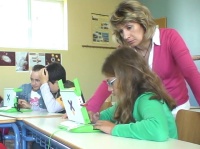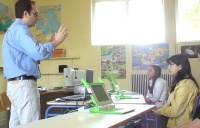This is the second part of Alexandros Kaloxylos' "Using XOs in a Greek classroom".
As for the creation of exercises with the use of squeak our impressions are both positive and negative. Positive is the fact that someone related to computer science can create or modify exercises quite easily. How good the exercise will be, is limited mostly from the imagination of the developer. The negative impressions derived from the fact that one should be very careful when presenting these exercises to kids with no experience with squeak. It took us some time to lock down buttons and images (we could not lock them all down since some exercises would not be executed properly). We did this because it was very easy for a kid to move parts of the exercise around, make it un-executable and miss the point of the exercise. Thus, it is very easy for the teacher to loose a lot of time for debugging in squeak. Note also, that exercises developed in desktops have to be checked again after porting them into the XOs since there are some differences in the positioning of items in the screen (possibly something to do with the differences in the screen analysis).

Greek pupils using the XO
As far as organizing a teaching unit with the use of XOs, we observed that it takes considerable more time in comparison to conventional methods of teaching. This is because the teacher needs to collect, develop and organise the necessary electronic material (books, bookmarks, slides, exercises etc). We are not very confident that if left alone, an average teacher can do this in a satisfactory level. Probably, the supporting material has to be available and managed centrally.
If this is followed and prior the commencement of a lesson, the teacher should download the supporting material and support the pupils. Even so, downloading and testing this material before a lecture as well as helping the pupils in technical issues will place more work to the teachers and will give them reasons for grouching.
Moreover, the conventional lecturing units have to be rearranged. The reason is that using the computers requires more time for some tasks where conventional teaching does not. For example, if a conventional exercise simply requires to read a text from a book a use a pencil to write the answer, using the OLPC concept may require
- a. connect to the internet
- b. download far more information that requires more processing time from the pupils
- c. load exercises
- d. debugging from teachers/pupils to network connections or exercises
In other words, children can do a lot more with OLPC but they also need more time.

Teacher-centric approach.
As far as the pupils are concerned, their experience with the OLPC was clearly a positive one. To begin with, they were quieter and more concentrated on their tasks. This may happened because it was a new experience for them but we also think that the use of the XO involves more complex mental processing from their side. The possibility of cooperating using an ad hoc connection resulted in an easy way of forming study groups and a quieter classroom. On the other side it is very easy to create Β«noise on the networkΒ», meaning the children exchanging information unrelated to their task without the teacher having any means of monitoring all groups at the same time.
In our experiment we did not follow strictly the constructivist system, but rather a mixed system between that and the teacher-centric model. Moreover, the pupils liked using the Internet, in one way or the other, in all their courses but they really enjoyed being interconnected and sharing spreadsheets or assigning exercises to each other and correcting them. Forming teams is far easier than through the traditional method.
Finally, the children really liked the design of the XO, they were impressed by the monitor (using it even to read a pdf file under the sun). Another point is that they preferred the older versions of sugar (used in the B2), since there were fewer different screens and it was less complex to switch among them to perform different tasks. Negative comments we received only for the mouse.
The exercises and the supporting material together with a 5-minute video (obviously all these are in Greek) can be found here.
Alexandros Kaloxylos is a lecturer in the Department of Telecommunications Science and Technology at the University of Peloponnese in Greece. He has also been a member of the OLPC Greece Initiative Committee since the very beginning.


Is using the XO to do individual work in the classroom not a waste of teacher's time?
I would expect the XO to be used when teachers are not available, eg, for homework assignments. Or for tasks that cannot be done in "lecture mode".
But I can understand this needs the children to be familiar with the XO first.
Winter
While I am glad this project is using an eclectic-synchretic approach (such nice Greek words!), it worries me a bit this sort of labeling and residual fear of so-called "teacher-centric" approaches.
There's nothing wrong with teacher-centric, *as long as teacher knows what he is doing*. Socrates didn't write a word. Plato, one of his students, did. But he didn't call them "community discussions"...
While currently it appears that the plan to deal with problem / untrained teachers is to somehow bypass them, my take is that the teacher should be, *by design* among those who benefit and grow and learn as part of a Good deployment, not just on how to use the XO, but be transformed in their approach to education itself.
Thus be as teacher-centered as he wishes and re-assured in his primary role of mentor, not just as part of the classroom furniture. (someone so prepared will allow for a lot of participation, if we did our job right in preparing him)
Yes, that is not the way we are operating yet, but unless we get there we are not only losing our potential best supporters, we are missing at transforming the educational system itself. This here is an example of work that takes some of these issues into account, glad to hear from Greece.
@Yama:
"While currently it appears that the plan to deal with problem / untrained teachers is to somehow bypass them, my take is that the teacher should be, *by design* among those who benefit and grow and learn as part of a Good deployment, not just on how to use the XO, but be transformed in their approach to education itself."
This is obvious. However, teachers are adults, and there is only one per classroom.
There are around 30 children in a classroom. Their development is well studied and "predictable". You can design on it.
Adults are much fewer, they are crucial, and a sizable fraction of them will develop new skills and insights at a glacial pace, if at all (sad but true for adults in general).
It seems therefor impossible to develop an educational strategy that depends directly on teacher development. Especially, if they cannot be extensively trained.
I am afraid that if you want to improve education, you will have to base it on the teachers you have. Any positive development of the teachers themselves is a gain, but too uncertain to rely on.
Winter
In 1952, a Greek royal tutor (and later ministerial aide) wrote "School Gardens" as a way of teaching science to argarian children; Negroponte is contuing that tradition.